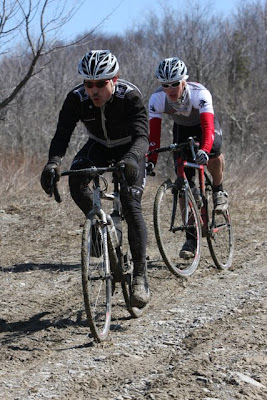Fixed wheel bikes (fixies) were much in evidence and there were some beautiful examples. The one that caught my eye though was the bike with two complete transmissions, one on either side of the bike.

When I asked the guy manning the booth what the idea was I was told that the second transmission was a safety measure that would come into play should a chain break or get unshipped. Normally with only one chain of course there is no means of stopping as the modern "fixie" rider wouldn't dream of installing a brake. Without brake or chain you are completely snookered. The thought of plummeting downhill with absolutely no means of stopping is somewhat unnerving. Rather than be seen with a brake these guys install two chainwheels, two chains and two sprockets. I shook my head in disbelief.
However it got me thinking about another bike I'd seen with a similar set-up but this one made a lot of sense. In 1982 Canadian rider Jocelyn Lovell rode the kilometre time trial at the World Championships in Leicester, England using a bike with two transmissions. His arrangement gave him two gear ratios, a lower gear to get away from the line and a higher gear that kicked in after about seventy metres. His ride in Leicester wasn't as good as he hoped for but the transmission worked well and it could not be faulted by the UCI commisaires.

Jocelyn's bike had a freewheel sprocket on the normal right hand side and a fixed sprocket on the left hand side. As he moved away from the line he drove through the RH sprocket and the left hand fixed sprocket began to unscrew from the hub. It being of smaller diameter it turned at a slower rate than the RH sprocket and being on the "wrong side" of the hub it would naturally unscrew. After about seventy metres the LH fixed sprocket came up against the lockring and at that point drive was through the LH side and the RH sprocket freewheeled. The distance traveled before the higher gear engaged could be adjusted by setting the position of the lockring. The bigger the space between lockring and sprocket at the start the longer the distance before the higher gear engaged.
Jocelyn experimented for some considerable time to come up with a combination of sprockets and chainrings that would not only give two suitable ratios but that would need chain lengths that would be at the correct tension. He settled on a low gear of 42x13 (87.2") and a high gear of 53x15 (95.4")
Jocelyn's two-speed transmission worked well but it was only one of the innovations that he tried. Note that in the above photograph he is riding a low profile frame, which he had built himself, fitted with "cow horn" handlebars and an extended seat tube connected directly to the saddle. All this was quite revolutionary in 1982. Tragically he was denied the opportunity to try it to it's full potential when he was hit by a dump truck in 1983 and paralyzed. That dump truck finished the career of one of Canada's finest athletes.
More about the fabulous cycling career of Jocelyn Lovell in a future blog.








